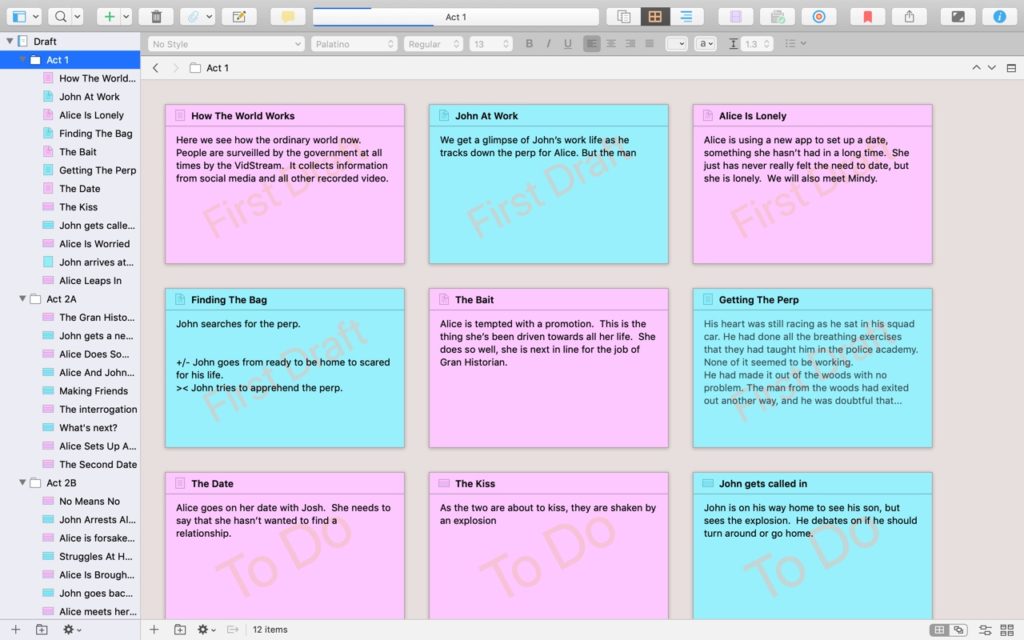Here’s Part 3 of my series on how I write. I’m going to be talking about structure of the story here, and the tool that I usually use: Scrivener. If you are a writer that writes long form, I would highly recommend getting and getting used to Scrivener. However, everyone’s process is different, so you can read what I have and adapt as you need too.
Plotting it out
At this point in the process, I have an idea of the image and the characters. Hopefully, I’ve fleshed out some things that I want to see in the story during that time period. So I have some ideas of what I want to tackle in the process here.
I used to start with the scene that I had in my mind and figure out where I wanted that scene to take place.
At this point, I’m in Scrivener so I’ll make a note card and briefly describe the scene. At this point, I usually use the card view in scrivener so that I can see how my story is structured. Here’s my last NaNo novel carded out.

On the card, I’ll write a brief description of the scene. I try to keep it simple for now. Something like:
Girl wakes up from a dream where she murdered someone. It felt real.
This was my starting point. I’d work on how I wanted the story to get to this point, and where it would go from there.
I’ve changed recently though.
Thanks to reading pan the book, I think the book does still have lots of great advice for a beginning writer, and I’ll try to do a review on it in the future.)
I start with where I want my character to start and where I want them to end. This way I know how I want my character to progress.
I will create cards based on the beginning and the end. Beginnings are always a little easier for me because I’ve planned out my character. I know where they came from and where I want to start from. Hopefully, I’ve gotten a scene in my mind that will help me show some aspect of my character. My heroine was a hard worker and married to the job, so it was easy for my to place her at work to begin with.
Starting this way also allowed me to establish how the world works. My heroine worked as s government employee that worked on surveillaning the collective video stream for evidence against criminals. By starting with a scene of her doing her job, I show that she’s a hard worker and that the world works a certain way.
I’m not done building the world or the character, but I felt like it was a strong first scene.
Endings are tougher for me. I like to have an idea of how I would end a story but I find that my character will grow in a different way while I’m writing. Still, I try to know what I want to go. This card probably won’t be the same by the time I get actually get to the ending in my first draft.
And that’s okay!
Writing is fluid. You can always go back and edit.
Now that the beginning and end have been drafted, I look at the next two scenes: The middle and the Act 3 break.
The middle

The middle point of a story needs to see the hero at an emotional point. If you look at the hero myth by Campbell, this is where the hero is overconfident. He or she should be heading towards some type of fall. This is where the hero thinks that they can’t lose. I try to figure out what is going to be the worse thing for my character in the story and put them through that emotional torture.
For my NaNo story, my heroine has put all her faith in the government and in this scene, the government and her job lets her down. She realizes that her faith has been placed in the wrong thing. She doesn’t know how she will keep going.
Act 3 break
Like Snyder says in his book, when you break into Act 3 this the emotional drama here needs to be opposite what it was in the middle. Your character has gone through the wringer, they’ve grown and improved.
Again going back to NaNo Story, my hero has learned that her life was basically wrong the entire time, but she also knows that she has to do something about it. She starts to get serious about what she’s doing to stop it. Hopefully the audience wants to see the hero succeed so they are ready for her to take on the path she has to take.
Everything else

Once those scenes are established I’ll try to tackle the Act 2 break, where I try to figure out how the character
Everything else is the fun stuff. What kind of events and torture can I put my character through? What can I do to show the audience that my character is caring, that she is a workaholic, that she wants to be loved? Those are the things that fill in the cracks. This is the fun stuff.
So now that I’ve gotten things plotted out, it’s time to write! Right?
It could be if that’s your process, but since this is a series about how I write, I figured I’d string you along for a few more posts. Just kidding, a little. I still have a little more groundwork to do before I get to the actual writing.
So check by next week, when I talk (in a shorter post, hopefully) about emotional scenes.
Discover more from JSwordSmith
Subscribe to get the latest posts sent to your email.
